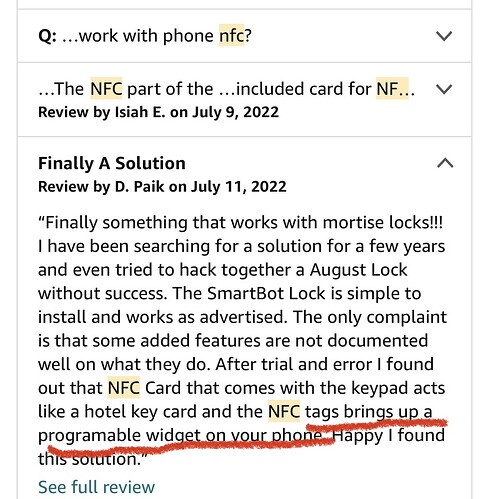It seems like the most common desire in this thread is a dead simple, RFID only, no internet, over-thumbturn (same as gimdow and switchbot) solution. A big benefit I see of using existing deadbolts is the addon stuff has almost no requirement to be sturdy (metal) anymore. As long as the external module just sends over the tag data and doesn’t do any validation, there shouldn’t be bad downsides to the external module being trivial to smash or access the internals of, right? (Of course there are some downsides, but on the “security by obscurity” debate I’m of the opinion that if what you want is something with comparable or better security to your actual lock, any deadbolt add on tag unlock system realistically already more than fulfills that, even if most of the electronics are on the outside of the door)
It would be cool if printing could be used for most mechanical parts (mostly the housings and electronics mounts, but from what I’ve seen, even printed things like gears can be surprisingly reliable) and COTS mechanical (heatset inserts bolts etc) and electrical parts bought in bulk by someone and sold soldered together in kits at cost + 20% or whatever. Maybe this project could finally push to a V1 if the lock design is taken care of by the door, and part manufacture mostly taken care of by the user (don’t have to worry about batch size). I’m assuming many people interested in this have access to a printer anyways and pre-assembled kits can be sold for those that don’t, or that don’t want to do the assembly process.
For a no-bells system, the only electronics needed should be a motor, two battery holders, two bluetooth chips, a LF antenna, a microcontroller, and some type of sensor(s) (two limit switches keeps it nice and simple and cheap). is there anything expensive I’m missing there? If not, I can’t see that BOM running more than $50 or so, although I’m not very most familiar with prices of this kind of stuff. Plus maybe $20 for all the non-printed mechanical parts.
It seems to me like the thing most are looking for, at least on here, is a lot simpler than a) anything on the market that works with tags, and b) a lot of the options that have been looked into for open-source manufacture thus far. I personally don’t care about any internet integration, encrypted signals, deadbolt replacements, any tag other than RFID, etc. The only “extra” features I can see being useful to me (and presumably others wanting a simple and relatively cheap add in type thing) are notification of low battery and confirmation of locking, both could be done with an outside-facing LED or beeper.
I’m also a fan of replacing the added-on thumb turn with a button to solve the problem of it being relatively difficult to turn by hand because of the relatively high torque motor (implemented a bit up-thread in the capstone project post, a version of which with better battery life would meet all my needs). Then you would only encounter the high torque when using an actual key, which doesn’t seem to be much of an inconvenience to me, as long as it is physically possible. Just give an RFID tag to anyone coming to your house a lot, the key is a backup.
